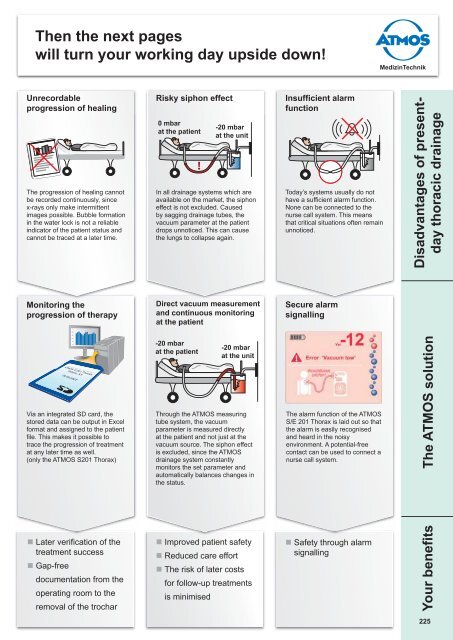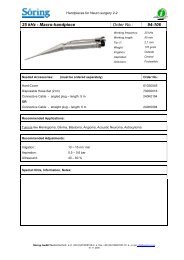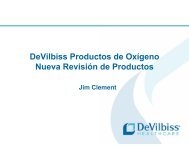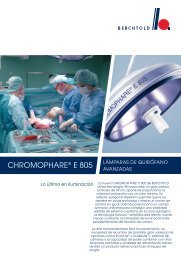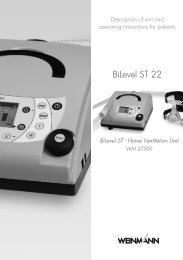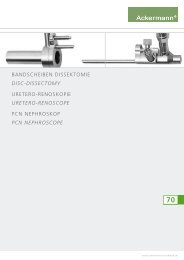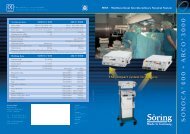ATMOS S 61 Servant the
ATMOS S 61 Servant the
ATMOS S 61 Servant the
Create successful ePaper yourself
Turn your PDF publications into a flip-book with our unique Google optimized e-Paper software.
25<br />
20<br />
15<br />
10<br />
5<br />
0<br />
Then <strong>the</strong> next pages<br />
will turn your working day upside down!<br />
MedizinTechnik<br />
Unrecordable<br />
progression of healing<br />
The progression of healing cannot<br />
be recorded continuously, since<br />
x-rays only make intermittent<br />
images possible. Bubble formation<br />
in <strong>the</strong> water lock is not a reliable<br />
indicator of <strong>the</strong> patient status and<br />
cannot be traced at a later time.<br />
Risky siphon effect<br />
0 mbar<br />
at <strong>the</strong> patient<br />
!<br />
-20 mbar<br />
at <strong>the</strong> unit<br />
In all drainage systems which are<br />
available on <strong>the</strong> market, <strong>the</strong> siphon<br />
effect is not excluded. Caused<br />
by sagging drainage tubes, <strong>the</strong><br />
vacuum parameter at <strong>the</strong> patient<br />
drops unnoticed. This can cause<br />
<strong>the</strong> lungs to collapse again.<br />
Insufficient alarm<br />
function<br />
Today’s systems usually do not<br />
have a sufficient alarm function.<br />
None can be connected to <strong>the</strong><br />
nurse call system. This means<br />
that critical situations often remain<br />
unnoticed.<br />
Disadvantages of presentday<br />
thoracic drainage<br />
Monitoring <strong>the</strong><br />
progression of <strong>the</strong>rapy<br />
Direct vacuum measurement<br />
and continuous monitoring<br />
at <strong>the</strong> patient<br />
Secure alarm<br />
signalling<br />
Via an integrated SD card, <strong>the</strong><br />
stored data can be output in Excel<br />
format and assigned to <strong>the</strong> patient<br />
file. This makes it possible to<br />
trace <strong>the</strong> progression of treatment<br />
at any later time as well.<br />
(only <strong>the</strong> <strong>ATMOS</strong> S201 Thorax)<br />
-20 mbar<br />
at <strong>the</strong> patient<br />
-20 mbar<br />
at <strong>the</strong> unit<br />
Through <strong>the</strong> <strong>ATMOS</strong> measuring<br />
tube system, <strong>the</strong> vacuum<br />
parameter is measured directly<br />
at <strong>the</strong> patient and not just at <strong>the</strong><br />
vacuum source. The siphon effect<br />
is excluded, since <strong>the</strong> <strong>ATMOS</strong><br />
drainage system constantly<br />
monitors <strong>the</strong> set parameter and<br />
automatically balances changes in<br />
<strong>the</strong> status.<br />
The alarm function of <strong>the</strong> <strong>ATMOS</strong><br />
S/E 201 Thorax is laid out so that<br />
<strong>the</strong> alarm is easily recognised<br />
and heard in <strong>the</strong> noisy<br />
environment. A potential-free<br />
contact can be used to connect a<br />
nurse call system.<br />
The <strong>ATMOS</strong> solution<br />
Later verification of <strong>the</strong><br />
treatment success<br />
Gap-free<br />
documentation from <strong>the</strong><br />
operating room to <strong>the</strong><br />
removal of <strong>the</strong> trochar<br />
Improved patient safety<br />
Reduced care effort<br />
The risk of later costs<br />
for follow-up treatments<br />
is minimised<br />
Safety through alarm<br />
signalling<br />
Your benefits<br />
225


